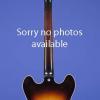This is an all original 6 watt 'tweed' narrow panel tube combo legend weighing just 13.00 lbs. The solid pine cabinet measures 13 1/2 inches wide x 12 inches high. The depth is 6 3/4 inches at the top expanding to 7 3/4 inches at the bottom. Three tubes (12AX7; 6V6GT; 5Y3GT), potentiometer stamped "137 6014" (CTS April 1960), one eight-inch Oxford Speaker with stamped code: "465-048" (Oxford 48th week of 1960), top control panel, two inputs, one volume knob, tweed covering, brown tweed-era grill. The letter code on the tube-chart is KD (K= 1961 and D = April). The serial number C15872 has been and also stamped onto the control panel. The tweed covering is remarkably clean and the original leather handle is in good shape. A wonderful little forty-seven-year old legend… just turn it up for real tube gain at a reasonable volume.
"With its three-tube circuit, it represents the simplest of all amplifier designs, and yet its performance is such that it has long been a favorite with collectors and players, despite its tiny 3W output.
At the time, its normal undistorted output would have been considered quite loud enough by the student players it was aimed at. Later its appeal to players lay in the fact that it could be made to distort at comparitively low levels and then fed either to a PA or a larger amplifier. The fact that its most appealing quality was an accident of design rather than a feature is a paradox to which we will return.
Distortion in an amplifier is, fundementally, the sound of circuitry in distress. In particular, it arises when one amplifying stage expects the next stage to produce more output than it is capable of supplying. When the Champ was designed and marketed for use with the low-powered guitar pickups of the day, the level of amplification provided by its single pre-amp tube was not enough to "overdrive" its single power output tube. Later, with more powerful pickups, higher signal levels would pass through the pre-amp tube, demanding ever more amplification and volume from the power output tube.
Fortunately for lovers of the overdriven sound, it was quite incapable of supplying the output levels required, and the distortion was the result. To a greater or lesser extent, all of Fender's early amplifiers display the same characteristic, although as their power increases the point at which the distortion sets in moves further back. Of course by modern standards they were all tiny amplifiers, rarely putting out more than 15W, and then into speakers that were simply not capable of taking the power, another (though much less sustainable) source of distortion." (John Morrish The Fender Amp Book, pp. 12-13).
Translate:

